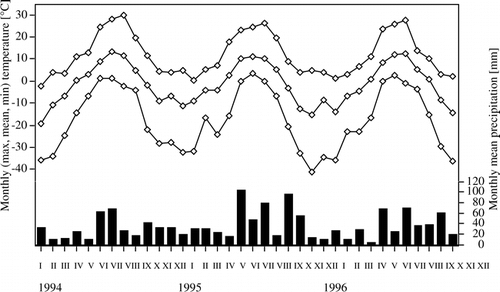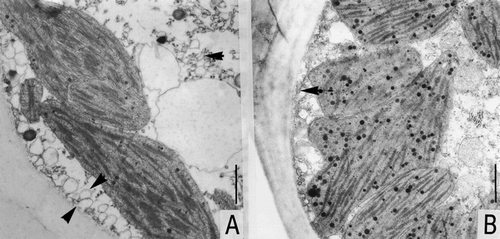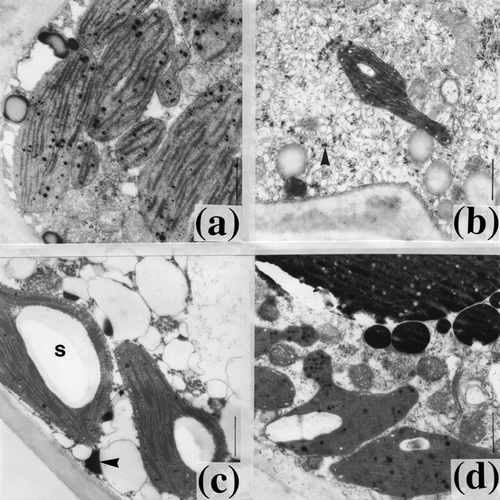Figures & data
FIGURE 1. Monthly temperature (°C, maximum, mean and minimum) and precipitation (mm) at Kevo, Finland, during 1994–1996

FIGURE 2. Transmission electron micrographs of mesophyll cells of previous year's pine needles at different stages of hardening. (A) Irrigated control (IC): hardened cytoplasm with tubular ER (arrow) and vesicular ER (between arrows near the plasma membrane); small lipid droplets. (B) Dry control (DC): the hardening process has just begun; longitudinal ER left in cytoplasm (arrow). Bar = 1μm

FIGURE 3. Transmission electron micrographs of damage symptoms observed in previous year's mesophyll cells of pine needles. (a) Dry control (DC): intact cell. (b) Cu + Ni treatment: Dense cytoplasm with a large number of ribosomes in both cytoplasm and chloroplasts (arrow). Notice the club-like shrunken chloroplast. Thylakoid membranes of chloroplasts appear to be swollen. (c) pH3 treatment: Vacuolation of cytoplasm. Note the dark accumulations in cytoplasm (arrow). (d) pH3 treatment: Protrusions in chloroplasts. Bar = 1μm, s = starch grain

TABLE 1 Cumulative amounts of sulfur (S), copper (Cu), and nickel (Ni) (mg m−2) added to the experimental plots at the Kevo site during 1991–1996 (Neuvonen, S., unpublished)
TABLE 2 Element concentrations (mean with SD) in the two youngest needle age classes. Statistically significant F (treatment df, error df) values are given for needle age and treatment. F-value for treatment is given separately for both needle age classes only in the cases where the treatment × needle age interaction was significant. Treatment means marked with bold differ significantly from IC (tested with LSD)
TABLE 3 Proportion of visible injuries (%) in the three youngest needle age classes per tree (mean with SD). See for abbreviations and details
TABLE 4 Proportions (%) of ultrastructural symptoms in mesophyll cells (mean with SD) in the two youngest needle age classes. ER = endoplastmic reticulum. For other abbreviations and details, see
TABLE 5 Hardening status of chloroplasts, mitochondria and cytoplasm and proportion of starch-containing chloroplasts in mesophyll cells. ER = endoplasmic reticulum. For other abbreviations and details, see